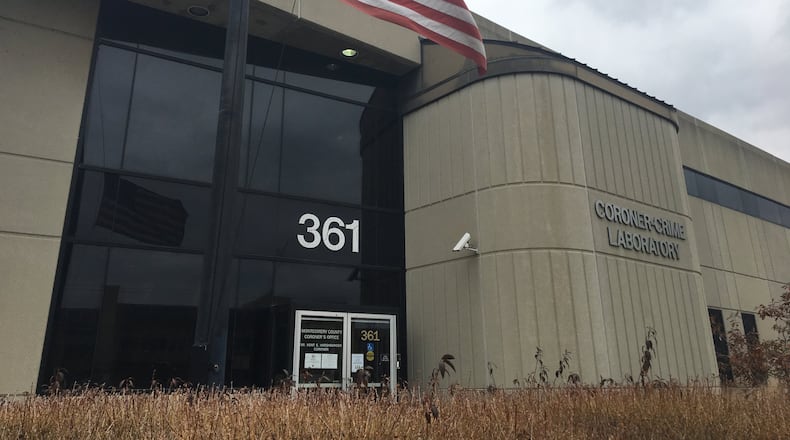The Montgomery County Coroner’s Office is working to formally identify Creachbaum’s presumed remains and determine a cause and manner of death.
While the coroner’s office declined to comment directly on the investigation, Sean Swiatkowski, chief deputy coroner at the Montgomery County Coroner’s Office, discussed how remains can be identified and the time and work that goes into death investigations.
Sometimes the coroner’s office receives remains that have already been identified by family or others who knew the individual.
If someone can visually confirm their identity, the coroner’s office can start the exam, which can include toxicology, histology and blood work.
“Sometimes, if certain people have a genetic disease, we may send a heart off for genetic studies or for a heart exam,” Swiatkowski said. “Once we get all that back then we’ll get our report together.”
Some deaths don’t require additional testing and the coroner’s office can just send off for a toxicology screening. Those typically take three or four weeks, and the coroner’s office can have the death report finished in a month to a month and a half.
When the coroner’s office receives unidentified remains, investigators will use fingerprints to identify a person, which can take about a day.
If the prints aren’t on record, the coroner’s office turns to dental records.
“Dental gets a little hard because you would think what with all our technology we have great dental records in the cloud somewhere,” Swiatkowski said. “But unfortunately you have to find the dentist they went to and pray they’re still open because if not, they destroy the records.”
Once the dentist has been located the deceased can be identified in about a day.
“Now the problem is when you don’t have any of those things,” Swiatkowski said. “Then you have to go the DNA route sent out to (the Ohio Bureau of Criminal Investigation).”
Due to BCI working with the entire state, it can take months for remains to be identified. Swiatkowski said the Montgomery County Coroner’s Office has at least 10 cases currently with BCI.
Montgomery County recently got an ANDE rapid DNA testing machine, which can be used for comparison DNA.
“It you have a sample from someone in the family and then you have a sample from the person who’s deceased you put it in this machine and it will run a DNA profile,” Swiatkowski said. “(It will) give you the profiles and then the machine calculates and gives a percentage of like 99.99% that this is who the person is.”
He said ANDE is good for cases where the coroner’s office has a mouth swab from a living relative. Rapid DNA testing is typically used in mass casualty incidents, such as the wildfires out in California, Swiatkowski said.
If the coroner’s office receives skeletal remains Swiatkowski said he has to grind down a bone and use a special mixture to extract the DNA.
It can take a few hours to get a sample prepared for the machine. Then it can take a few more hours for ANDE to complete the profiles.
“It really depends on how well preserved the bones are,” he said. “If it’s in the ground or there’s a lot of bacteria on it, you get a lot of interference. BCI is really good at getting rid of all that stuff and figuring out how to do it.”
The ANDE machine is good for clean samples, Swiatkowski said. If remains are decomposed or contaminated, the coroner’s office turns to BCI for an identification.
A preliminary autopsy report indicated the remains believed to be Creachbaum include an incomplete skeleton with “scant tissue” remnants.
Kendrick told detectives he kept the boy’s body in the house and put it in a deep freezer when it began to smell, according to Dayton Municipal Court records.
He reportedly used a suitcase to leave the boy in a grassy field and then returned a few weeks later to collect the bones.
He put the bones in a bag and left them on McClure Street, according to court documents.
If the coroner’s office is using BCI to identify Creachbaum’s presumed remains, it could take months for a formal identification.
The coroner’s office will also determine a cause and manner of death. There are five manners of death — accidental, natural, suicide, homicide and undetermined.
An undetermined death means investigators don’t know how the person died.
“The circumstances don’t add up and we don’t know why,” Swiatkowski said.
The condition of the remains can also play a large role in if a cause and manner of death can be determined.
Skeletal remains or remains without a lot of tissue can be difficult if the bones don’t show signs of an injury.
Swiatkowski said skeletal remains for a shooting victim may not show damage to the bones.
“Sometimes when that happens we’ll send the bones up to an anthropologist to see if there’s something that we just don’t see,” he said. “That can take several months because they lay everything out; they clean all the bones. They’re very particular and write a very extensive report.”
That process can take two or three months.
Swiatkowski said a common misconception with death investigations is the amount of time the process takes.
A lot of offices don’t have the manpower to handle the volume of work, which can be tedious and time consuming.
Even with rapid DNA technology the process can take hours to correctly prepare a sample.
“It really is a tedious process to make sure you get the right information,” he said.
About the Author
